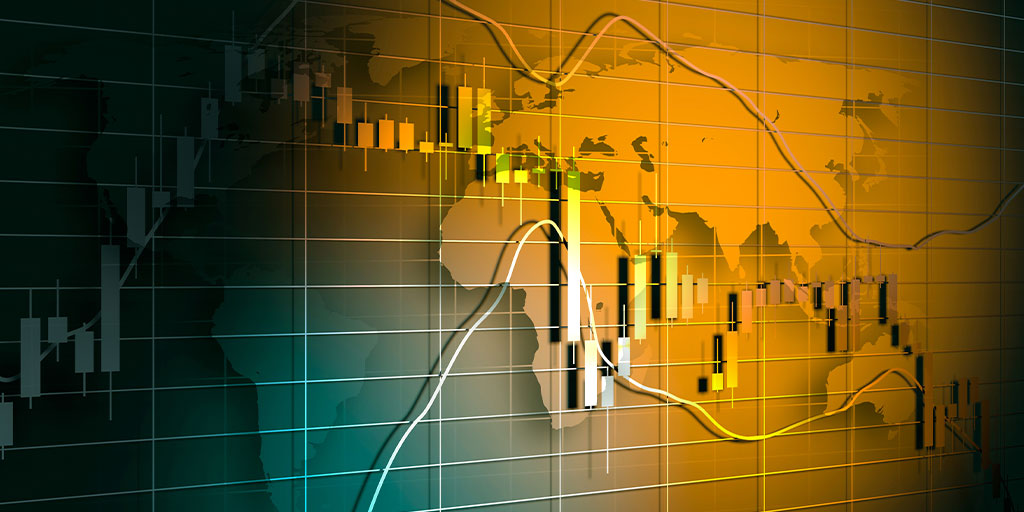This economic expansion is the longest in recorded American history. We’re in its 11th year. The cycle is maturing. Growth is slowing. Volatile price action the last 20 months is actually fairly normal for a late cycle. Though the S&P 500 is approaching the all-time highs reached in July, it hasn’t moved much from the highs first hit in January of 2018. In fact, the S&P was smack dab back at that level just three weeks ago. It’s been a lot of sideways action with sharp peaks and valleys. The same has been the case in the Bond Market, which is generally not this volatile. It’s seen its own peaks and valleys the last two years, with some really rapid moves. The Bond Market is important to watch. It keeps telling a story of caution. The Bond Market can intimidate anyone. James Carville rightly acknowledged that.
Stocks are staying elevated near all-time highs despite recent developments that create vulnerabilities:
Number 1: Growth is slowing. Economic data is increasingly weak around the globe. The Organization for Economic Co-Development, otherwise known as the OECD, cut almost all economic forecasts it made just four months ago. Growth is slowing at a faster rate. It now expects growth at a mere 2.9% this year. The Trade War is taking its toll. The OECD official statement said: “Our fear is that we are entering an era where growth is stuck at a very low level.” It went on to say that governments should aggressively take advantage to invest in and support these sluggish economies before they fall further. The OECD is the latest institution sounding the alarm over the state of the global economy. In the past two weeks, the Fed, the European Central Bank, the Bank of China and numerous of their peers have eased policy to shore up demand, urging governments at the same time that fiscal stimulus will be needed to ensure their efforts won’t be futile. That’s not healthy. In many ways, that’s part of the problem.
Number 2: The Market is addicted to monetary medicine. The Fed cut rates by ¼ point this week and signaled that might be it for now. There were three dissenters on the decision, which is a bigger number than expected. The Market is still expecting at least another rate cut this year. Fed Chair Powell did emphasize the committee decisions will be data-driven, and they are open to anything in order to extend this economic expansion. The Market response was volatile, also as expected, although losses were erased and the DOW and S&P closed in the green for the day. The President’s response was also expected, with more criticism of not doing enough. It’s still unbelievable to us that the Federal Reserve is cutting interest rates with the US Stock Market at all-time highs and a US Economy that continues to chug along. Growth is undeniably slowing around the globe, but the rest of the world is not part of the Fed’s guiding dual mandate. It’s become the 3rd.
To take a line from FedEx CEO Fred Smith, whose company is facing serious challenges and the stock, which we own, got whipped this week, people are “whistling past the graveyard about the US Consumer and the United States economy.” He’s not just the CEO of a Fortune 500 company with revenues tied to every region around the globe. He’s also an economist. So there’s that. The S&P 500 doesn’t reflect it, but there has been serious pain under the surface. FedEx was a really cheap stock before it reported earnings. It’s even cheaper now, though the lowered outlook sent some shockwaves through the system. Cheap stocks keep getting cheaper. There’s a lot of them out there below the surface. But the index has stayed elevated. For how much longer is the question we’d like to know. Believe me, we’d really, really like to know. But we never will in advance. In our business, we only know after the fact. That is why it is so critical to seek out and study signs and developments, and always anticipate.
Number 3: Geopolitical risks were already big. They got much bigger this week. Brexit has been a risk all along, which kept getting pushed out. October 31 is a deadline. That can just might get kicked again. But something else occurred that sent shocks through the global system. The attack on the Saudi oil facility was a clear example of vulnerabilities. The attacks took half of Saudi oil off the Market in an instant. It’s coming back online, but the damage was done. There has still been no response from the Saudis. Iran said any response would lead to war. The fact is, this attack was already an act of war. This is a huge risk. One of the greatest risks, perhaps is if Saudi Arabia does nothing. The US is pushing more sanctions to start. But that would send a message to the rest of the world. Iran tested the Saudi-American-Israeli alliance. Is it a coincidence that it came days after John Bolton was fired and days before the Israeli election? We are hyper-focused on this issue and will be on high alert all weekend.
Economic cycles need to run their course. Corrections and recessions are necessary to cut back the excesses and maintain a healthy balance. Preventing the natural flow can be harmful, with many unintended consequences. It delays the inevitable and could make things worse. The Stock Market wants Fed assistance. It craves quantitative easing. It seems addicted to monetary medicine. The Stock Market throws tantrums when it doesn’t get what it wants. Just look back at last December for perspective. Our plan is to stay defensive, and to keep fighting through this challenging two year period to preserve capital because the data is getting worse. This Market and this economy are very vulnerable to the outside elements which are beginning to infect the inside elements. Trade talks with China have begun again. It’s being reported that China is less frantic to do a deal than the Americans thought. It’s also been said that President Trump is not interested in a limited deal either. Sounds like they’re not close.
There was also an issue with the overnight “Repo” Market. The Fed had to backstop four days of overnight borrowing. There are new provisions in place that require banks to maintain excess liquidity ratios, in response to the Financial Crisis a decade ago. So the explanation was that it was a technical bump, which the Fed facilitated. Ok. Liquidity has been taken out of the Market. That’s another big risk for a Market that has become addicted to liquidity. It sounds like it was absorbed easily. What happens if things turn and stress returns? There’s another vulnerability.
The Market has absorbed many negative events and risks this week. You have to give it credit. We just won’t trust it blindly. You can’t trust without verification. We don’t see the verification.
Have a nice weekend. We’ll be back, dark and early on Monday.
Mike







